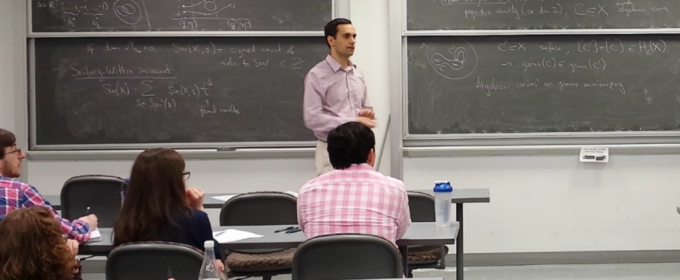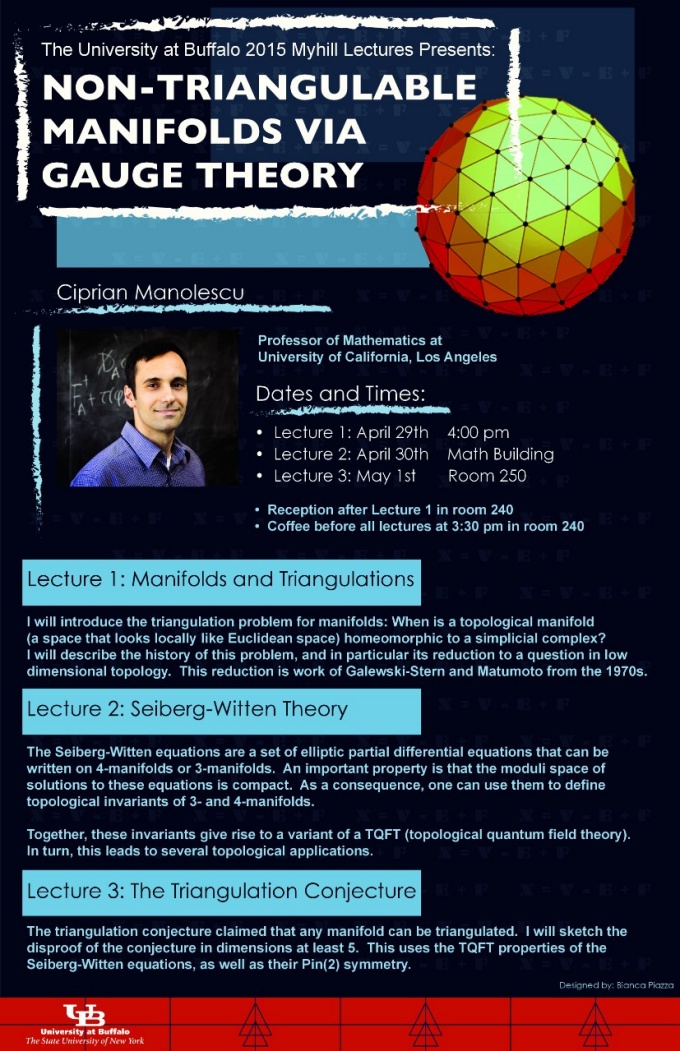Myhill Lecture Series 2015
Ciprian Manolescu
"Non-Triangulable Manifolds via Gauge Theory"

Ciprian Manolescu from UCLA delivers the 2014-15 Myhill lectures in April 2015.
Ciprian Manolescu, Professor of Mathematics at UCLA, presented the Myhill Lecture Series 2014-15. This 3-part lecture series was held in April 2015, and included a reception in honor of Professor Manolescu after the first lecture. Manolescu earned his BA from Harvard in 2001. In 2002 he won the Morgan Prize for undergraduate research. He continued at Harvard, earning his PhD in 2004 under the supervision of Peter Kronheimer.
From 2004-2008 he was a Clay Research Fellow while holding postdoctoral appointments at Princeton & IAS and then Columbia University. Since 2008 he has been at UCLA, where he is Professor of Mathematics. He has held visiting research positions at MSRI, the Simons Center for Geometry and Physics, and the National Center for Scientific Research in Paris.
Manolescu is the only person in history to earn a perfect score three times at the International Math Olympiad, representing Romania. In 2012, he was awarded a prize of the European Congress of Mathematics, held every four years. EMS prizes are awarded to researchers not older than 35 years, of European nationality or working in Europe, in recognition of excellent contributions in mathematics. The citation for Manolescu reads “An EMS-prize goes to him for his deep and highly influential work on Floer theory, successfully combining techniques from gauge theory, symplectic geometry, algebraic topology, dynamical systems and algebraic geometry to study low-dimensional manifolds, and in particular for his key role in the development of combinatorial Floer theory.”
Non-Triangulable Manifolds via Gauge Theory
Lecture 1: Manifolds and triangulations
I will introduce the triangulation problem for manifolds: When is a topological manifold (a space that looks locally like Euclidean space) homeomorphic to a simplicial complex? I will describe the history of this problem, and in particular its reduction to a question in low dimensional topology. This reduction is work of Galewski-Stern and Matumoto from the 1970s.
Lecture 2: Seiberg-Witten theory
The Seiberg-Witten equations are a set of elliptic partial differential equations that can be written on 4-manifolds or 3-manifolds. An important property is that the moduli space of solutions to these equations is compact. As a consequence, one can use them to define topological invariants of 3- and 4-manifolds.
Together, these invariants give rise to a variant of a TQFT (topological quantum field theory). In turn, this leads to several topological applications.
Lecture 3: The triangulation conjecture
The triangulation conjecture claimed that any manifold can be triangulated. I will sketch the disproof of the conjecture in dimensions at least 5. This uses the TQFT properties of the Seiberg-Witten equations, as well as their Pin(2) symmetry.
